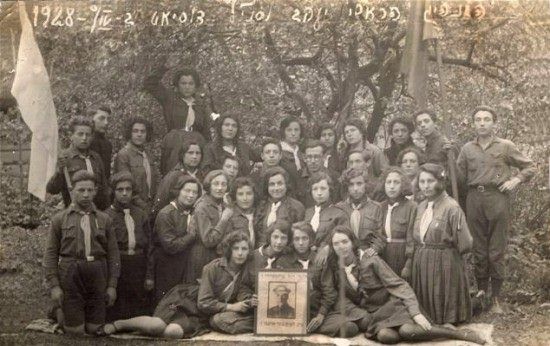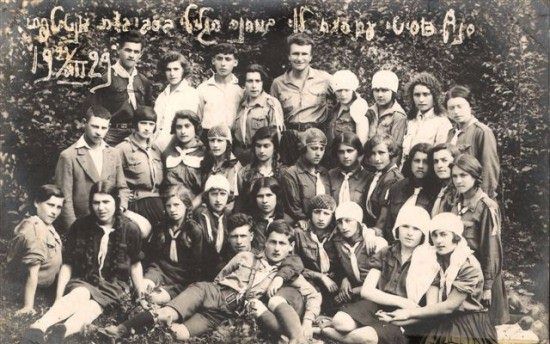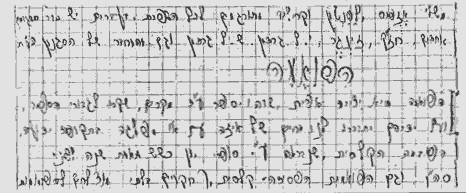[Page 161]
Shlichim[1] from Eretz Yisrael
Yoel Zeif
Translated by Judy Grossman
All the activities in the movement were conducted in Hebrew. All the doctrine that was taught, the discussions, the lectures, the ideas, were all conducted in Hebrew. People who spoke Yiddish were fined. We received the material for the activities from the center in Kovno [Kaunas], and we also received letters and telegrams from Eretz Yisrael. When a lecturer or emissary came from Eretz Yisrael we would gather in the synagogue and thirstily drink in his words about Eretz Yisrael.
I remember Chaim Levitt's visit. He was already an adult, and we were children compared to him, and every word of his was a message. Dov Levitt (son of Hirshl) also came, and they didn't reveal then that he had left Eretz Yisrael. We knew that he had come to the shtetl for a visit. He came to the clubhouse and told us about Eretz Yisrael and the kibbutzim, and we sat open-mouthed and swallowed every word. Once a letter arrived from Eretz Yisrael, which said (in Yiddish): “I am sitting on the tree and eating figs”. The term “fige” is also used for fica[2], i.e. nothing, so we could understand that there was nothing to eat. We knew that conditions in Eretz Yisrael were harsh.
|
|
| |
| With Yaacov Gottlieb, the emissary from the movement leadership, in Padustelis (a village near Dusiat)
From right to left, back row, standing: David Zak, Micha Slep, Tzipora Zeif, Itale Orlin, Zelda, Charit, Freidke Slep, Mirka Slep and her sister Henia, Dov Shub
Second row: (-), Noah Poritz, emissary Yaacov Gottlieb, Yoel Zeif, Rivka Melamed, Rachel Blacher
Kneeling: Tzirka Kagan, Micha Baron, Elke-Reizke Krut (daughter of Shepsl), Iska Zeif, Elka Melamed, Rachel Slovo, Etka Schneiderman, Rasya Glick, Rachel Shub, Rivka Scop, Sheinke Yossman, Meir Slep
Seated: Chava Shub, Nechamka Yudelowitz, Bunka Chaitowitz and Sarka Melamed holding the picture of the hero Yosef Trumpeldor…
|
Footnotes
- Emissaries Return
- Fica - thumb between the forefingers, an indication of “nothing”. Return
[Pages 161-163]
I Traversed the Shtetls of Lithuania
By Levi Ron (Rosenzweig)
Translated by Judy Grossman
I was a pioneer in Eretz Yisrael, and in 1929 I arrived in Lithuania as an emissary of the Hashomer Hatzair movement. For the Jewish youth, Hashomer Hatzair was a kind of window to “enlightened” Europe, a window to education, for which the young people hungered so strongly. As an emissary I didn't sit in an office, but wandered all over. I covered all the shtetls of Lithuania, and I absolutely fell in love with the Jewish youth in Lithuania and the movement in Lithuania, which was a beautiful and aware movement, and there I absorbed the Lithuanian Yiddish that I speak. Many people in Lithuania spoke Hebrew, and I felt emotional when I traveled in a sleigh and spoke Hebrew with the driver. I didn't find anything like that in Poland, the land of my birth.
The movement was not religious, but did not fight against the religion. I remember the Simchat Torah celebration in the Hassidic Shtibl (small synagogue) in Kovno [Kaunas] well. When the prayers ended, the movement members joined the dancing. This occasion symbolized the renewal of the ancient tradition joined with the national moment.
I remember my visit to Dusiat very well. I took the train from Kovno to Utian [Utena], to Aniksht [Anyksciai], and from there I reached Dusiat by sleigh. The temperature was twenty degrees below zero. I spent two or three days in the shtetl. I visited the ken [cell] there, and discussed with its leadership the problems of educational work. The life of the young people in the shtetl flowed through the movement, and they spent their free time there.
The work in the ken was divided by age. Ages fourteen to seventeen were the educators. In discussions and meetings they examined various issues. A “book of life” was kept in the ken, which contained the stories of the members who raised personal problems before the counselors, everything that bothered them. We reviewed the “ten commandments” of the movement, which did not deal at the time with a political outlook, but with what was called “an outlook on life”, as for example, “The shomer loves nature”, “Ahi-Ezer” and “Ahi-Semech” (charity societies).
I was asked to prepare a draft of the discussion, which included relating to the environment and moral foundations, fraternity and awareness of the life of the nation. It must be remembered that from these foundations the Hashomer Hatzair movement grew into a political unit, with a socialist outlook, Zionist radicalism and the demand for aliya and personal realization (at that time this meant going to live in a kibbutz in Eretz Yisrael). There were studies in the ken, in addition to what was taught in school. The teachers cooperated with the ken. I remember that that is how it was in Dusiat, and I should emphasize that they didn't behave that way in every shtetl. Much was done in the movement to increase the members' education, which at that time was absolutely minimal. For instance, they learned biology and anthropology, things that were absolutely inaccessible to them. My job was to draw up a work program that would suit each ken. I would sit with each body and group. There was a library in every shtetl, and I constructed a work program based on the books I found in it.
I visited the school and told them about Eretz Yisrael. I had a notebook containing the names of the counselors, the composition of the groups and my impressions. I didn't receive special training. What I received in the movement I passed on, and to this was added my experience with the problems of Eretz Yisrael. I brought the message of Eretz Yisrael with me, its essence.
|
|
| |
| Levi Rosenzweig: I feel emotional when I see the photograph of the ken of Dusiat. I remember this occasion well
From right to left, top row: Rivka Scop, Breinka Shapira, Rasya Kagan, Henia Slep, Levi Rosenzweig (emissary), Rivka Melamed, David Zak, Sara Melamed, (-)
Second row: Nechamka Yudelowitz, Etka Schneiderman, Belke Krut, Elka Melamed, Sheinke Yossman, Slovka Yoffe (from Abel),Zeldka Charit, Mashka Slep, Lenka Visakolsky, Freidke Slep, Meir Slep
Third row: Tzirka Kagan, Itale Orlin, Rachel Shub, Rachel Slovo, Rivka Pores, Hene-Bailke Blacher (daughter of Hirshl), Mirka Karanowitz, Mirka Slep, Rachel Blacher (daughter of Hirshl)
Seated: Noah Poritz, Yoel Zeif
|
Rivka Melamed's Notebook[1]
The ken of Dusiat stood out in its longing for knowledge and expanding its horizons. When I came to Dusiat Rivka Melamed was the head of the ken, and she carried out her job very seriously. Rivka was sentimental, rational and intelligent. She didn't accept things automatically. She had literary talent, a talent that afterwards found expression in our kibbutz Mishmar Ha'emek.
“What is the purpose of the notebook?” – Rivka's daughter Nava asked me. In front of me I see a notebook in Rivka's beautiful handwriting, from the year 1927 containing summaries about various literary forms – a novel, idyll, poem – with suitable grades. This was the notebook of a counselor. This was the way the counselors prepared for the activities. Don't forget that the age difference between the counselors and the group members was not very great.
I feel emotional when I see the photograph of the ken of Dusiat “with brother Levi”. I remember this occasion well.
I am moved to see the photograph of the ken of Dusiat “with brother Levi”. I remember this occasion well. I remember those days with great fondness.
Footnote
- [55] Rivka Melamed's private collection Return
This material is made available by JewishGen, Inc.
and the Yizkor Book Project for the purpose of
fulfilling our
mission of disseminating information about the Holocaust and
destroyed Jewish communities.
This material may not be copied,
sold or bartered without JewishGen, Inc.'s permission. Rights may be
reserved by the copyright holder.
JewishGen, Inc. makes no representations regarding the accuracy of
the translation. The reader may wish to refer to the original material
for verification.
JewishGen is not responsible for inaccuracies or omissions in the original work and cannot rewrite or edit the text to correct inaccuracies and/or omissions.
Our mission is to produce a translation of the original work and we cannot verify the accuracy of statements or alter facts cited.
 Dusetos, Lithuania
Dusetos, Lithuania
 Yizkor Book Project
Yizkor Book Project
 JewishGen Home Page
JewishGen Home Page
Yizkor Book Director, Lance Ackerfeld
This web page created by Lance Ackerfeld
Copyright © 1999-2024 by JewishGen, Inc.
Updated 12 Sep 2009 by LA





